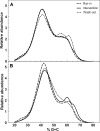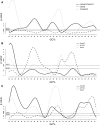Gut microbiota of healthy elderly NSAID users is selectively modified with the administration of Lactobacillus acidophilus NCFM and lactitol
- PMID: 21853265
- PMCID: PMC3682059
- DOI: 10.1007/s11357-011-9294-5
Gut microbiota of healthy elderly NSAID users is selectively modified with the administration of Lactobacillus acidophilus NCFM and lactitol
Abstract
Ageing changes gut microbiota composition and alters immune system function. Probiotics, prebiotics and synbiotics may improve the health status of elderly individuals by modifying the intestinal environment and the microbiota composition, and by stimulating the immune system. In this work, we studied the effects of synbiotic supplementation on the gut microbiota of healthy elderly volunteers. Fifty-one elders were randomly assigned to consume either a synbiotic dietary supplement or a placebo in addition to their usual diet for a 2-week period. The synbiotic product consisted of the probiotic Lactobacillus acidophilus NCFM and the prebiotic lactitol and was ingested twice a day, with a total daily dose of 10 g lactitol and 2 × 10(10) cells of probiotic bacteria. Before, during and after the intervention period fecal quantities of six phylogenetic bacterial groups were determined using quantitative PCR, and relative changes in total microbiota composition were assessed by percent guanine-plus-cytosine profiling. The microbiota profiles showed certain relative changes within the microbial community, and indicated an increase of bifidobacteria levels during synbiotic supplementation. Quantification by PCR confirmed the in changes in the microbiota composition; for example increases in total levels of endogenous bifidobacteria and lactobacilli were recorded. Throughout the 6-week study period there was a decrease unrelated to intervention in the Blautia coccoides-Eubacterium rectale bacterial group levels and Clostridium cluster XIVab levels, but this decrease appeared to be halted during the synbiotic intervention. In conclusion, putatively beneficial changes in microbiota were observed in the elderly subjects supplemented with the synbiotic product.
Figures



References
-
- Altermann E, Russell WM, Azcarate-Peril MA, Barrangou R, Buck BL, McAuliffe O, Souther N, Dobson A, Duong T, Callanan M, Lick S, Hamrick A, Cano R, Klaenhammer TR. Complete genome sequence of the probiotic lactic acid bacterium Lactobacillus acidophilus NCFM. Proc Natl Acad Sci USA. 2005;102:3906–3912. doi: 10.1073/pnas.0409188102. - DOI - PMC - PubMed
-
- Ballongue J, Schumann C, Quignon P. Effects of lactulose and lactitol on colonic microflora and enzymatic activity. Scand J Gastroenterol Suppl. 1997;222:41–44. - PubMed
-
- Bartosch S, Fite A, Macfarlane GT, McMurdo ME. Characterization of bacterial communities in feces from healthy elderly volunteers and hospitalized elderly patients by using real-time PCR and effects of antibiotic treatment on the fecal microbiota. Appl Environ Microbiol. 2004;70:3575–3581. doi: 10.1128/AEM.70.6.3575-3581.2004. - DOI - PMC - PubMed
Publication types
MeSH terms
Substances
LinkOut - more resources
Full Text Sources
Other Literature Sources
Molecular Biology Databases
